Installing new flooring has the potential to be one of the most expensive, and time consuming, projects you could possibly do around the home. That being said, an inexpensive and easy option does exist. Installing vinyl plank flooring is perhaps one of the easiest, and least expensive, methods around for replacing your flooring. If you are interested in using this option, then simply follow these general guidelines. Keep in mind that the manufacturer may have some specific instructions for their brand of flooring. In the event that they contradict with what is said here, follow the instructions of the manufacturer first.
Materials:
Procedure:

MAX Power! A powerful lithium-ion drill/driver that delivers 0-to-650 RPM and 115 inches-per-pound of torque in a lightweight, easy-to-use package. An anti-slip soft grip and LED worklight makes this tool a delight to use. Check out Black & Decker 20-Volt Cordless Drill/Driver today!
Fixing a loose tile is an extremely easy home repair job that anyone can do. Many people think that when they get a ...
Discover MoreWhile you could remove old tile adhesive from tile with steel wool or a putty knife, you take the chance of scratching or ...
Discover MoreInstead of replacing your carpet the next time you damage it, why not try some simple carpet repairs. By conducting these ...
Discover More2015-06-28 20:23:58
chris
why must you acclimate to the humidity of the room when the product is waterproof/resistant? it does not expand or contract like wood or laminate. I see no purpose to acclimate vinyl planks. in fact I never have before an install and have had no issues what so ever
2014-10-05 17:12:51
A.P.
I have an issue where the walls have some gaps and dont touch the concrete floor that I want to cover up. ie some of the planks will slide right under the wall, others won't so I'm not sure what to do as we are supposed to leave a 1/8 '' gap around. I was hoping to use spacers around the walls but once I remove them some of the floor will move under and could distort the floor? I am a layperson, have never done floor and plan to use the vinyl plank I can cut with a utility knife. Should I put some drywall mud or something to get rid of the gaps at the bottome of the walls?
2012-09-08 12:04:58
Connie
Is there an installation tip which helps to prevent migration gaps between the ends of the planks?
2012-03-13 13:37:53
DAvid
My name is David and I am currently a contractor for My Fathers Floors in Abilene Tx. Ive put down many vynl plank floors and this method is extremely precise based on it not being that hard to lay plank in the first place. a couple tips i will leave #1, Many people use different methods staggering the floor cutting 12 inch 24 36 intervals at the end of every isle so the pattern doesnt match up. it looks fake dont do it..do it at random but in pattern. 5-12 17-24 28-36 then use left overs at the end for no waste
Copyright © 2025 Sharon Parq Associates, Inc.
Comments